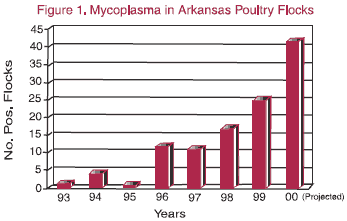



Mycoplasmosis - A Continued Threat
By Dr F. Dustan Clark, Extension Poultry Veterinarian at University of Arkansas Cooperative Extension Service. He describes the symptoms and effects of these samll bacteria in poultry.The data in Figure 1 indicate that there has been a continued steady increase in outbreaks of Mycoplasma in Arkansas poultry in the last few years. In fact, if the trend continues, there will be a record number in Arkansas during 2000. The purpose of this article is to discuss symptoms and effects of the disease in poultry, help poultry producers better recognize the disease and prevent the spread of mycoplasmas to other poultry flocks.

Mycoplasma are small bacteria that can cause disease in a variety of poultry species. There are four species of mycoplasma that affect commercial poultry: Mycoplasma gallisepticum (MG), Mycoplasma synoviae (MS), Mycoplasma meleagridis (MM) and Mycoplasma iowae (MI). The first two species (MG and MS) are responsible for the current mycoplasma problems in Arkansas poultry.
Mycoplasma gallisepticum (MG) causes a respiratory disease in chickens and turkeys infecting the sinuses, air sacs, trachea and bronchi of the bird after an incubation period of 1-3 weeks. Chickens with the disease have a cough, eye inflammation (conjunctivitis) and a nasal discharge. A drop in egg production can also be seen in breeders and layers. Turkeys usually have a severe swelling of the sinuses, nasal discharge and frothy eyes. Affected chickens and turkeys do not gain well and may die or be downgraded at slaughter. The disease can be much more severe when birds with mycoplasmosis are also infected by bacteria such as E. coli or viruses. The disease is almost always more severe in turkeys than in broilers.
* "Mycoplasma are small bacteria that can cause disease in a variety of poultry species." |
Mycoplasma synoviae (MS) can also cause a respiratory infection. In addition, MS can infect the joints and tendon sheaths of the bird. Chickens infected with MS have reduced growth, swollen joints (hocks) and footpads, and may breast blisters. While air sacculitis (air sac infection) can occur and chickens may show respiratory distress, MS usually does not cause any symptoms when the respiratory tract is infected. Turkeys have similar signs and lesions to broilers, but usually lameness is the most predominant problem. As with MG the problem is more severe when bacteria or viruses also infect the birds.
Several methods are used to diagnose the disease in poultry. The clinical signs and lesions can be used to make a presumptive diagnosis, which is confirmed by isolation of the bacteria, blood testing and/or specialized tests such as the Polymerase Chain Reaction (PCR test) on tracheal swabs Successful treatment of mycoplasma infections is unpredictable since there is a great deal of variation in the sensitivity of mycoplasma to antibiotics. There are vaccines available for use in MG infections, but since they are live vaccines there is concern that the vaccine strain will spread to other birds. In fact, many states do not allow vaccination for MG or at least restrict vaccine use since most MG vaccine strains have shown a potential to spread to unvaccinated chickens and turkeys. There has been little use of vaccination for MS infections. The preferable method of controlling mycoplasma infections is prevention.
Preventative measures are designed to exclude the bacteria from the flock. One step in excluding mycoplasma from flocks is maintaining clean breeder stock. This is done in the poultry industry by the National Poultry Improvement Plan, which is a testing and control program for egg transmitted diseases such as MG and MS. This program has been extremely successful nationwide and the majority of poultry in the United States are mycoplasma free.
Unfortunately, a few problems still arise and as such an increased awareness and biosecurity are needed. Points to remember for better biosecurity are as follows:
- Restrict visitor access to only necessary visitors.
- All visitors should wear protective gear (including coveralls, boots or boot covers and headgear) that can be disposed of or disinfected on the farm.
- Foot dips should be available on each farm at each poultry house.
- Do not share equipment, egg flats, etc., between farms.
- Vehicles should be cleaned and disinfected between farms.
- Wildlife and vermin should be restricted from poultry houses.
Dr F. Dustan Clark is Extension Poultry Veterinarian at University of Arkansas Cooperative Extension Service. This article was published in Avian Advice newsletter (Volume 2, Number 1; Fall 2000)
October 2008








